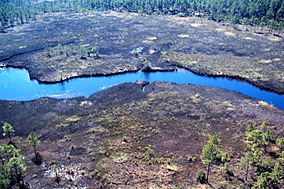Grand Bay National Wildlife Refuge facts for kids
Quick facts for kids Grand Bay National Wildlife Refuge |
|
|---|---|
|
IUCN Category IV (Habitat/Species Management Area)
|
|

West over Bayou Heron showing pilings from old logging road bridge in center of photo. Grand Bay, Mississippi
|
|
| Location | Mobile County, Alabama, Jackson County, Mississippi, United States |
| Nearest city | Grand Bay, Alabama |
| Area | 32,000 acres (130 km2) |
| Established | 1992 |
| Governing body | U.S. Fish and Wildlife Service |
| Website | Grand Bay National Wildlife Refuge |
The Grand Bay National Wildlife Refuge is a special protected area created in 1992. It helps keep safe one of the biggest untouched pine savanna areas along the Gulf Coast. This amazing refuge is found near Grand Bay, Alabama in both Mobile County, Alabama and Jackson County, Mississippi. When it's fully set up, it will cover more than 32,000 acres (130 km2) of land and water! It's part of the larger National Wildlife Refuge system, which protects nature all across the United States. While some parts are hard to reach, you can often visit by boat or from the Mississippi side.
Contents
Explore the Habitats of Grand Bay
The Grand Bay National Wildlife Refuge has many different kinds of natural areas. These include wet pine savannas, which are like grassy plains with scattered pine trees. There are also maritime forests, which are woodlands found near the sea.
Watery Worlds and Coastal Lands
You can find tidal flats, which are muddy or sandy areas uncovered at low tide. There are also non-tidal wetlands, which are wet areas not affected by the ocean's tides. Salt pans are flat areas where saltwater has evaporated, leaving behind salt. The refuge also has salt marshes, which are grassy coastal wetlands, along with bays and bayous.
Amazing Plants and Animals
The different habitats at Grand Bay National Wildlife Refuge are perfect homes for many kinds of birds, plants, and other creatures. Some birds live here all year, while others just visit during their long migrations.
Birds of the Refuge
Many colorful and interesting birds live or visit the refuge. You might spot a bright red scarlet tanager or a black-throated green warbler with its unique song. Other birds include the black-and-white warbler, the eastern towhee, and the clever gray catbird. Look out for the beautiful painted bunting and the shy white-eyed vireo.
Carnivorous Plants: Nature's Insect Traps
The refuge is home to nine types of amazing carnivorous plants! These plants have special ways to catch insects. They include pitcher plants, which have deep, slippery tubes that trap bugs. You can also find butterworts, which have sticky leaves, and sundews, which sparkle with sticky droplets. These plants eat insects to get nutrients like nitrogen, which is missing from the swampy soil where they grow.
Images for kids



